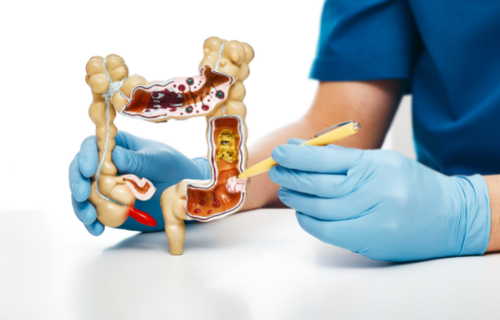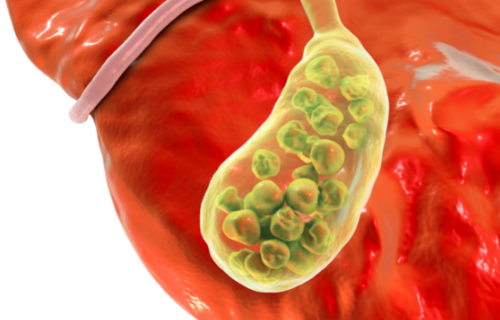Difference Between Gallstones and Polyps

Introduction
Gallstones and polyps both affect the gastrointestinal system.
Although they originate in different regions, both can cause significant symptoms and require additional treatment.
Gallstones generally affect the upper gastric region, and polyps the lower region involving the colon.
Various diagnostic tools are used to differentiate the two, which is an important aspect for correct treatment!

Definition
Gallstones
Gallstones (generally referred to as cholelithiasis) are formed in the gallbladder and can be both asymptomatic of cause serious symptoms leading to health emergencies. More specifically, they comprise pieces of solid material that form in this small organ situated just under your liver.
The gallbladder functions as an organ which both stores and releases bile which is generated in your liver. This bile (and bile salts) help aid the digestion process of foods you take in. Bile also functions to discard waste products made during the breakdown of red blood cells. These include cholesterol and bilirubin.
Polyps
A polyp is defined as a raised, flat or stalk-like growth on the inner lining of the large intestine (the colon) or the rectal region. They occur as different types of which the adenomas and sessile serrated types are prone to developing into potential types of cancer.
Polyps are found in about 30% of the human adult population between the age of 45-50. This is true for both men and women, as well as throughout all ethnic groups.
Pathophysiology’s and Symptoms
Gallstones
When a gallstone impacts in the neck of the gallbladder or in the cystic duct it causes a state of gallstone colic. This gallstone attack or state of colic generally presents in the following way:
- Experience of sudden and severe pain in the right upper corner of the abdomen that most often spreads across the back to the right shoulder
- Bouts of vomiting
- Excessive sweating during the gallstone attack or state of colic.
- A healthy patient when not experiencing gallstone colic or states of attacks
Polyps
Genetic changes in the cell structures in the lining of the colon affects the way in which cell cycles generally operate and result in polyps.
Polyps generally present with the following symptoms:
- Rectal bleedings that can be visually detected
- Loss of weight and abdominal pain
- Changes in the bowel movements normal to you
- Iron deficiency anaemia that cannot be easily explained
Risks and Treatment
Gallstones
The largest risk factors for gallstones include lifestyle factors such as being excessively overweight (or obesity), the use of oral contraceptive pills by women, being of the female gender, and hormone changes during pregnancy.
When gallstones are detected but there are no associated symptoms, then treatment usually is not needed. However, when symptoms do tend to occur then the gallstones are treated with lifestyle modifications to avoid biliary colic. In the most severe cases the patient might need the gallbladder to be entirely removed via a laparoscopic cholecystectomy surgery or an endoscopic retrograde cholangiopancreatography (ERCP) to unblock a bile duct.
Polyps
Although polyps are a result of genetic changes, there are various lifestyle factors which can contribute to the formation of polyps.
This includes smoking and excessive alcohol consumption, lack of exercise and being overweight, eating unhealthy foods, and a family history of inflammation and cancers.
When polyps are found, then a qualified surgeon will most likely remove it for further testing (to determine the type). Further reduction of the risk of developing polyps is also advised through healthy lifestyle changes, increased exercise, and taking a low dose of aspirin to reduce these polyps and potentially cancer.
Table of comparison between gallstones and polyps

Summary
Polyps are characterized in the large intestine and gallstones in the gallbladder.
The symptoms differ quite significantly. Gallstones often present with excruciating pain and sweating during gall attacks. On the other hand, polyps present with bleeding and changes in bowel movements. Abdominal pain is less common but can occur too. Anaemia without a clear cause can be a symptom of colon or rectal polyps upon diagnosis.
Where the gallstones are treated surgically and by lifestyle changes, polyps are treated similarly but are often treated with aspirin too.
The risk factors for both include unhealthy lifestyle habits, but there are risk factors unique to both. In the case of gallstones, a hormonal component often plays a big role (through female hormones as well as hormonal contraceptives). In the case of polyps, the specific risk factors largely include a genetic component.
FAQ
Are gallstones and polyps the same?
No. Gallstones are pieces of solid material that form in your gallbladder, a small organ situated just under your liver. A polyp is defined as a raised, flat or stalk-like growth on the inner lining of the large intestine (the colon) or the rectal region.
Can gallstones be mistaken for polyps?
Intestinal polyps are not associated with the gallbladders. However, when gallbladder polyps are present then they can be misdiagnosed for gallstones.
Can gallstones cause polyps?
Gallstones can cause the development of gallbladder polyps but are generally not associated with colon polyps.
- Difference Between a Cochlear Implant and Normal Hearing - October 4, 2022
- Difference Between Obstructive and Restrictive Spirometry - September 11, 2022
- The Difference Between White Box and Black Box Testing - September 11, 2022
Search DifferenceBetween.net :
Leave a Response
References :
[0]Cleveland Clinic. “Colon Polyps”. https://my.clevelandclinic.org/health/diseases/15370-colon-polyps
[1]Cleveland Clinic. “Gallbladder Polyps”. https://my.clevelandclinic.org/health/diseases/21821-gallbladder-polyps#:~:text=You%20may%20be%20more%20likely,Cholecystitis.
[2]Gossage, James., Bultitude, Matthew and Corbett, Steven. Browse’s Introduction to the Symptoms & Signs of Surgical Disease. 2021. CRC Press: Florida. pp: 644
[3]Heuman, Douglas and Mihas, Anastasios. Gallstones (Cholelithiasis) Treatment & Management. 2019https://emedicine.medscape.com/article/175667-treatment?src=mbl_msp_android&ref=share
[4]Sarkut, Pinar., Kilicturgay, Sadik., Ozer, Ali.,Ozturk, Erson., and Yilmazlar, Tuncay. “Gallbladder polyps: Factors affecting surgical decision”. World Journal of Gastroenterology. 2013, vol. 19, no. 28, pp: 4526-4530.
